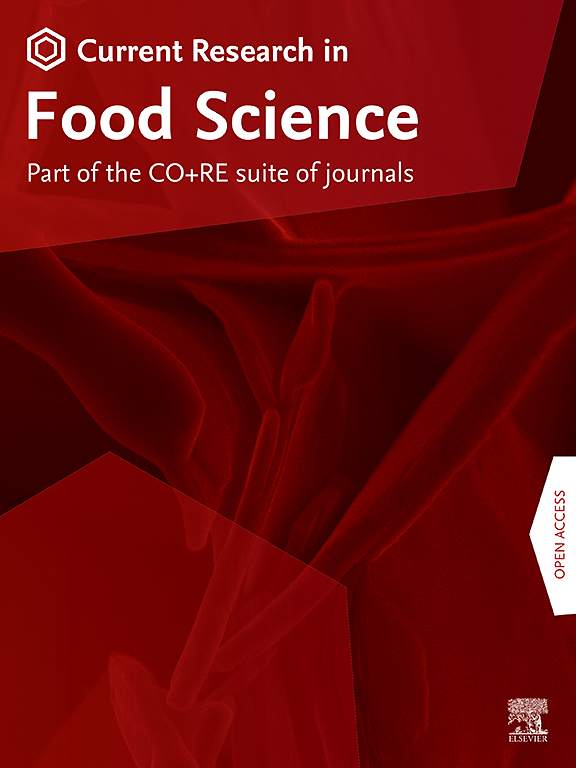Structure and properties of citrus pectin as influencing factors of biomarkers of metabolic syndrome in rats fed with a high-fat diet
IF 7
2区 农林科学
Q1 FOOD SCIENCE & TECHNOLOGY
引用次数: 0
Abstract
Pectin, widely used as a food and pharmaceutical ingredient, has garnered attention in recent years due to its bioactive properties. We conducted an in vivo study to evaluate the effects of citrus pectin on biomarkers of metabolic syndrome (MtS), including lipid profile, hypertension, and adipose tissue. Supplementing a high-fat diet (60% energy from fat) with 20% pectin for 4 weeks significantly reduced body weight and fat accumulation, improved insulin resistance, and decreased circulating leptin levels, demonstrating a beneficial effect on MtS. Pectin exhibited excellent viscosity, emulsifying properties, and water-holding capacity, forming a viscous gel in the gastrointestinal tract. This gel delays gastric emptying, enhances satiety, and reduces food and calorie intake, leading to lower weight gain in rats fed pectin. Its viscosity also interferes with lipase activity, lipid hydrolysis, and absorption, while its oil-holding capacity may help prevent lipid absorption. The presence of galactose in pectin's structure showed potential for improving insulin resistance. Furthermore, both degree of esterification (DE) and pH influence pectin's functionality. At acidic pH levels, such as those found in the stomach and duodenum, high methoxyl pectin (HMP) retains fats and bile salts more effectively, contributing to better cholesterol regulation. These effects, combined with the antioxidant properties of pectin, helped reverse arterial hypertension associated with MtS. Overall, our findings highlight the potential of citrus pectin as a natural bioactive ingredient for combating obesity-related disorders, complementing pharmacological treatments and promoting health through innovative dietary approaches.

柑橘果胶的结构和性质对高脂饮食大鼠代谢综合征生物标志物的影响
果胶作为一种广泛应用于食品和制药的原料,由于其生物活性特性,近年来引起了人们的广泛关注。我们进行了一项体内研究,以评估柑橘果胶对代谢综合征(MtS)生物标志物的影响,包括脂质谱、高血压和脂肪组织。在高脂肪饮食(60%的能量来自脂肪)中添加20%的果胶,持续4周,显著降低体重和脂肪积累,改善胰岛素抵抗,降低循环瘦素水平,显示出对MtS的有益影响。果胶具有优异的粘度、乳化特性和持水能力,在胃肠道中形成粘性凝胶。这种凝胶延缓胃排空,增强饱腹感,减少食物和卡路里的摄入,导致喂食果胶的老鼠体重增加减少。它的粘度也会干扰脂肪酶活性、脂质水解和吸收,而它的持油能力可能有助于防止脂质吸收。果胶结构中半乳糖的存在显示出改善胰岛素抵抗的潜力。此外,酯化度(DE)和pH都影响果胶的功能。在酸性pH值水平下,如胃和十二指肠,高甲氧基果胶(HMP)更有效地保留脂肪和胆汁盐,有助于更好地调节胆固醇。这些作用,结合果胶的抗氧化特性,有助于逆转与MtS相关的动脉高血压。总的来说,我们的研究结果强调了柑橘果胶作为一种天然生物活性成分的潜力,可以对抗肥胖相关的疾病,补充药物治疗,并通过创新的饮食方法促进健康。
本文章由计算机程序翻译,如有差异,请以英文原文为准。
求助全文
约1分钟内获得全文
求助全文
来源期刊

Current Research in Food Science
Agricultural and Biological Sciences-Food Science
CiteScore
7.40
自引率
3.20%
发文量
232
审稿时长
84 days
期刊介绍:
Current Research in Food Science is an international peer-reviewed journal dedicated to advancing the breadth of knowledge in the field of food science. It serves as a platform for publishing original research articles and short communications that encompass a wide array of topics, including food chemistry, physics, microbiology, nutrition, nutraceuticals, process and package engineering, materials science, food sustainability, and food security. By covering these diverse areas, the journal aims to provide a comprehensive source of the latest scientific findings and technological advancements that are shaping the future of the food industry. The journal's scope is designed to address the multidisciplinary nature of food science, reflecting its commitment to promoting innovation and ensuring the safety and quality of the food supply.
 求助内容:
求助内容: 应助结果提醒方式:
应助结果提醒方式:


